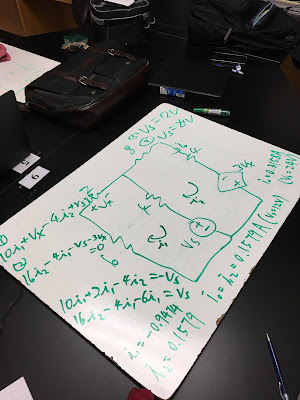Here is the picture of us using everycircuit to solve the problem.
After that, we talked about Thevenin's Theorem.
To me, Thevenin's Theorem is a important concept that all electrical engineer has to know because it gives engineer an easy tool to build a complex circuit in another form of existence.
Here is the picture of us solving the circuit using thevenin's theorem.
After the learning of the concept, we did our lab.
The purpose of this lab is to verify the thevenin's theorem by comparing the measured and calculated results.
Here is the result that we calculated.
Resistance error for this lab:
1k(0.96k), 2.2k(2.15k), 4.7k(4.6k), 6.8k(6.68k), 1.8k(1.74k), 6.8k(6.68k)
Our measured values for the Thevenin resistance and the open circuit voltage is 7.2kohms and 0.448volt, which compares to the calculated value (7.7kohms and 0.46volt), and they have 6.49% and 2.6% of error.
Here are the photos of us actually taking the data from the circuit.
On part three, we chose a 4.5k ohms resistor as our load resistor, and we calculated that the voltage across the load will be 0.187volt, and from our measurement, we have 0.165volt. The error yields at around 11%, which is not very precise because the value of the resistors in our calculation are different than the actual values of the resistors.
On part four, we used the potentiometer to generate our measured values of thevenin resistance 7.2ohms, then we supply the circuit with the designated value of voltage which is 0.488 volt. After that, we put the same resistor that we used as a load in part three into the thevenin circuit, and we get the voltage drop is 0.167volt, and if we compare this value to our calculation, the error yield is 1.1%.
 |
Summary:
Today, we learned about thevenin's theorem which is helpful for engineer to build a simple circuit to represent a complex circuit. In our experiment, the calculation and measurement both match up with each other, so I think it is a very useful tool while implementing in real life situation. For the maximum power of the load resistance, it exists when the load resistance is the same as the thevenin resistance. Before and after the value, the curve will be smaller than that because it is a concave down curve.





































